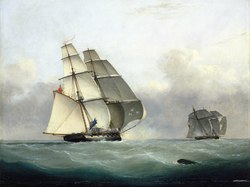File:The Capture of the slaver Gabriel by HMS Acorn, 6 July 1841 RMG BHC0628.tiff

Original file (4,800 × 3,598 pixels, file size: 49.41 MB, MIME type: image/tiff)
Captions
Captions
Summary[edit]
| Nicholas Matthews Condy: The Capture of the slaver Gabriel by HMS Acorn, 6 July 1841
|
||||||||||||||||||||||||
|---|---|---|---|---|---|---|---|---|---|---|---|---|---|---|---|---|---|---|---|---|---|---|---|---|
| Artist |
|
|||||||||||||||||||||||
| Author |
Nicolas Matthew Condy, the Younger |
|||||||||||||||||||||||
| Title | ||||||||||||||||||||||||
| Object type |
painting object_type QS:P31,Q3305213 |
|||||||||||||||||||||||
| Genre |
marine art |
|||||||||||||||||||||||
| Description |
English: The Capture of the slaver Gabriel by HMS Acorn, 6 July 1841 The ‘Acorn’ brig was one of the British West Africa Squadron, established in 1808 in order to enforce the suppression of the Atlantic slave trade, following the British Act of Abolition the previous year. In early July 1841 ‘Acorn’ spotted the ‘Gabriel’, an Iberian pirate vessel, gaining on the British barque ‘India’, which was carrying migrants to Australia. A contemporary report in the ‘Journal du Havre’ described the capture of the ‘Gabriel’, as communicated by one Captain Blay of the ‘Jeune Pauline’, who had just arrived at Le Havre from Rio de Janeiro: The English brig Acorn having, in lat. 5.N perceived at great distance a vessel pillaging another, made chase, and instantly the Gabriel hoisted all her sail, and endeavoured to escape. At three in the afternoon the Acorn fired, and the Gabriel returned the fire, at the same time hoisting Portuguese colours. The chase continued for 12 hours, during the whole of which time firing was kept up by both vessels, but eventually the Gabriel was dismasted, and captured. She was sent to St Helena, but her crew, consisting of fifty-eight men, Spaniards and others, were put on board an English vessel at Rio. The captain jumped overboard during the chase, with all his papers. The merchandise found on board the Gabriel was valued at 8000 pounds. The Acorn had not time to ascertain to what country the vessel which was being pillaged by the Gabriel belonged, but she carried English colours. Condy’s painting shows the moment early in the chase when the two vessels in full sail have opened fire on one another; but it is still a matter of suspense whether the pirate vessel will be taken or will escape. A print was produced after the painting, ‘H.M. Brig Acorn 16 Guns in Chase of the Piratical Slaver Gabriel’ (PAG9194) though it is clear from the above account that the ‘Gabriel’ was not carrying a slave cargo on this occasion. Nonetheless, the picture shares the same moral message as many other marine paintings of this period, showing British Navy vessels in action against slave ships (see, for example, BHC0625). It is signed ‘N. M. Condy’ on the floating debris in the foreground. |
|||||||||||||||||||||||
| Date |
1841 date QS:P571,+1841-00-00T00:00:00Z/9 |
|||||||||||||||||||||||
| Medium |
oil on board |
|||||||||||||||||||||||
| Dimensions | Frame: 520 mm x 625 mm x 90 mm;Painting: 305 mm x 405 mm | |||||||||||||||||||||||
| Collection |
institution QS:P195,Q7374509 |
|||||||||||||||||||||||
| Current location | ||||||||||||||||||||||||
| Accession number |
BHC0628 |
|||||||||||||||||||||||
| Notes | Signed. | |||||||||||||||||||||||
| References | ||||||||||||||||||||||||
| Source/Photographer | http://collections.rmg.co.uk/collections/objects/12120 | |||||||||||||||||||||||
| Permission (Reusing this file) |
The original artefact or artwork has been assessed as public domain by age, and faithful reproductions of the two dimensional work are also public domain. No permission is required for reuse for any purpose. The text of this image record has been derived from the Royal Museums Greenwich catalogue and image metadata. Individual data and facts such as date, author and title are not copyrightable, but reuse of longer descriptive text from the catalogue may not be considered fair use. Reuse of the text must be attributed to the "National Maritime Museum, Greenwich, London" and a Creative Commons CC-BY-NC-SA-3.0 license may apply if not rewritten. Refer to Royal Museums Greenwich copyright. |
|||||||||||||||||||||||
| Identifier InfoField | Acquisition Number: 1927-158 id number: BHC0628 |
|||||||||||||||||||||||
| Collection InfoField | Oil paintings | |||||||||||||||||||||||
Licensing[edit]
|
This is a faithful photographic reproduction of a two-dimensional, public domain work of art. The work of art itself is in the public domain for the following reason:
The official position taken by the Wikimedia Foundation is that "faithful reproductions of two-dimensional public domain works of art are public domain".
This photographic reproduction is therefore also considered to be in the public domain in the United States. In other jurisdictions, re-use of this content may be restricted; see Reuse of PD-Art photographs for details. | |||||
File history
Click on a date/time to view the file as it appeared at that time.
| Date/Time | Thumbnail | Dimensions | User | Comment | |
|---|---|---|---|---|---|
| current | 15:20, 24 September 2017 |  | 4,800 × 3,598 (49.41 MB) | Fæ (talk | contribs) | Royal Museums Greenwich Oil paintings (1841), http://collections.rmg.co.uk/collections/objects/12120 #1323 |
You cannot overwrite this file.
File usage on Commons
The following 3 pages use this file:
File usage on other wikis
The following other wikis use this file:
- Usage on www.wikidata.org
Metadata
This file contains additional information such as Exif metadata which may have been added by the digital camera, scanner, or software program used to create or digitize it. If the file has been modified from its original state, some details such as the timestamp may not fully reflect those of the original file. The timestamp is only as accurate as the clock in the camera, and it may be completely wrong.
| Width | 4,800 px |
|---|---|
| Height | 3,598 px |
| Bits per component |
|
| Compression scheme | Uncompressed |
| Pixel composition | RGB |
| Image data location | 140 |
| Number of components | 3 |
| Number of rows per strip | 3,598 |
| Bytes per compressed strip | 51,811,200 |
| Data arrangement | chunky format |


